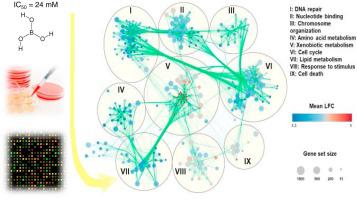Journal of Trace Elements in Medicine and Biology ( IF 3.6 ) Pub Date : 2020-05-30 , DOI: 10.1016/j.jtemb.2020.126573 Aysegul Tombuloglu 1 , Hulya Copoglu 2 , Yesim Aydin-Son 1 , N Tulin Guray 2

|
Background
Boron is a prominent part of the human diet and one of the essential trace elements for humans. Dietary boron is mostly transformed into boric acid within the body and has been associated with desirable health outcomes. Non-dietary resources of boron, such as boron-based drugs and occupational exposure, might lead to excessive boron levels in the blood and provoke health adversities. The liver might be particularly sensitive to boron intake with ample evidence suggesting a relation between boron and liver function, although the underlying molecular processes remain largely unknown.
Methods
In order to better understand boron-related metabolism and molecular mechanisms associated with a cytotoxic level of boric acid, the half-maximal inhibitory concentration (IC50) of boric acid for the hepatoma cell line (HepG2) was determined using the XTT assay. Cellular responses followed by boric acid treatment at this concentration were investigated using genotoxicity assays and microarray hybridizations. Enrichment analyses were carried out to find out over-represented biological processes using the list of differentially expressed genes identified within the gene expression analysis.
Results
DNA breaks were detected in HepG2 cells treated with 24 mM boric acid, the estimated IC50-level of boric acid. On the other hand, pleiotropic transcriptomic effects, including cell cycle arrest, DNA repair, and apoptosis as well as altered expression of Phase I and Phase II enzymes, amino acid metabolism, and lipid metabolism were discerned in microarray analyses.
Conclusion
HepG2 cells treated with a growth-inhibitory concentration of boric acid for 24 h exhibited a senescence-like transcriptomic profile along with DNA damage. Further studies might help in understanding the concentration-dependent effects and mechanisms of boric acid.
中文翻译:

硼酸在半最大抑制浓度下对人肝肝癌细胞系 (HepG2) 的体外作用。
背景
硼是人类饮食的重要组成部分,也是人类必需的微量元素之一。膳食硼主要在体内转化为硼酸,并与理想的健康结果有关。硼的非膳食资源,如含硼药物和职业暴露,可能会导致血液中硼含量过高并引发健康问题。肝脏可能对硼的摄入特别敏感,有充分的证据表明硼与肝功能之间存在关系,尽管潜在的分子过程仍然很大程度上未知。
方法
为了更好地了解与硼酸的细胞毒性水平相关的硼相关代谢和分子机制,使用 XTT 测定法确定了硼酸对肝癌细胞系 (HepG2)的半数最大抑制浓度 (IC 50 )。使用遗传毒性测定和微阵列杂交研究在该浓度下硼酸处理后的细胞反应。使用基因表达分析中鉴定的差异表达基因列表进行富集分析以找出过度表达的生物过程。
结果
在用 24 mM 硼酸(硼酸的估计 IC 50 水平)处理的 HepG2 细胞中检测到 DNA 断裂。另一方面,在微阵列分析中发现了多效性转录组学效应,包括细胞周期停滞、DNA 修复和细胞凋亡以及 I 期和 II 期酶的表达改变、氨基酸代谢和脂质代谢。
结论
用抑制生长的硼酸浓度处理 24 小时的 HepG2 细胞表现出类似衰老的转录组学特征以及 DNA 损伤。进一步的研究可能有助于了解硼酸的浓度依赖性影响和机制。









































 京公网安备 11010802027423号
京公网安备 11010802027423号